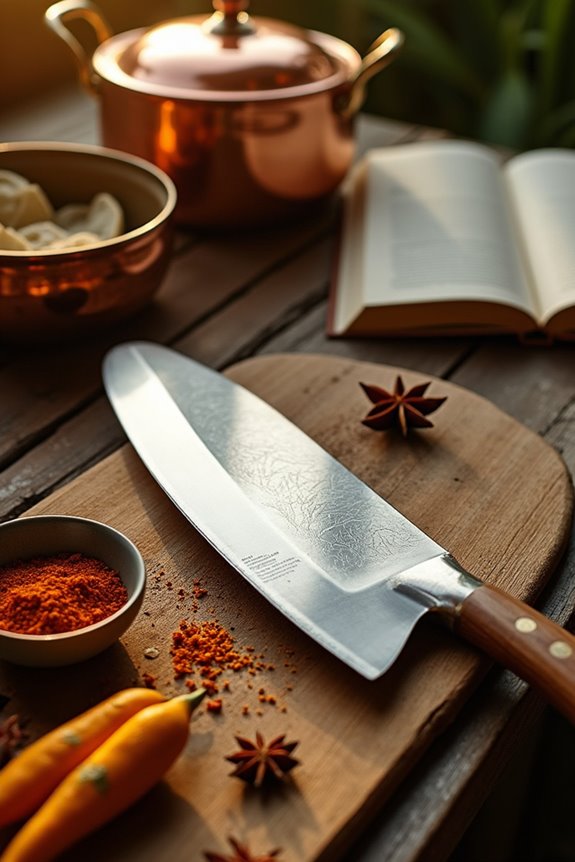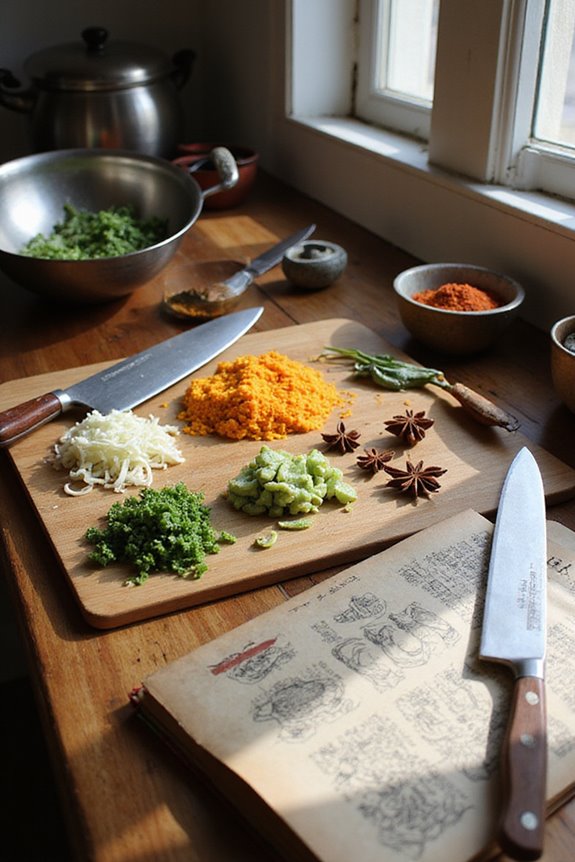What makes a good Chinese cleaver? Well, let’s chop it down! We love a broad, 6 to 8-inch blade that’s perfect for slicing and scooping. Its square tip makes it easy-peasy to prevent ingredient splatters. Plus, a comfy handle is key for those long cooking sessions—think of it as your kitchen buddy! And don’t forget to keep it sharp for those magical cuts, like the ones you’d impress your relatives with during holiday feasts. Stick around, and we’ll share more exciting tips!
Key Takeaways
- A good Chinese cleaver features a broad, rectangular blade to ensure versatility in chopping, slicing, and scooping ingredients.
- High-quality materials, such as high-carbon stainless steel, ensure durability, rust resistance, and long-lasting sharpness.
- An ergonomic, barrel-shaped grip allows for comfortable handling during extended cooking sessions, reducing strain on the hands.
- Proper weight distribution enhances control and power in cutting while minimizing wrist fatigue during repetitive tasks.
- Maintenance through hand washing and regular sharpening with a whetstone preserves the cleaver’s performance and longevity.
Design and Build Characteristics
When it comes to the delightful world of cooking, the design and build characteristics of a good Chinese cleaver take center stage! Let’s dive right into its magical blade dimensions. Typically ranging from 6 to 8 inches, the broad, rectangular blade allows for versatility in our kitchens. Its square tip is a thoughtful design philosophy that prevents ingredients from splitting and helps us scoop them effortlessly.
Here’s why we love this tool:
- Hefty & Balanced: The front-weighted design keeps us chopping with ease!
- Comfortable Handle: An ergonomic, barrel-shaped grip lets us cook all day long.
In a nutshell, this cleaver packs a punch for every festive feast! Who knew a little weight could bring so much joy in the kitchen? Additionally, having a blade made from high carbon steel enhances cutting efficiency and ensures long-lasting sharpness.
Essential Cutting Techniques

Let’s plunge into the delightful domain of essential cutting techniques for our trusty Chinese cleaver! Mastering these techniques can make your cooking feel magical. Here are some key cutting techniques and blade motions to try:
- Push cut: Start with the thin tip and press down for precision.
- Guillotine chop: Straight downward for hard veggies—think of it as a holiday gift wrap!
- Slide cut: A horizontal glide for efficient slicing.
- Rocking motion: Perfect for mincing herbs using the blade’s curve.
Don’t forget our hand positioning! The claw grip keeps fingers safe, while pinching the cleaver’s spine gives you control. Just remember, practice makes perfect, so let’s chop, slice, and dice our way to culinary joy together! Additionally, using a heat-resistant tool will enhance your cutting experience and ensure safety while cooking.
Quality Materials and Construction
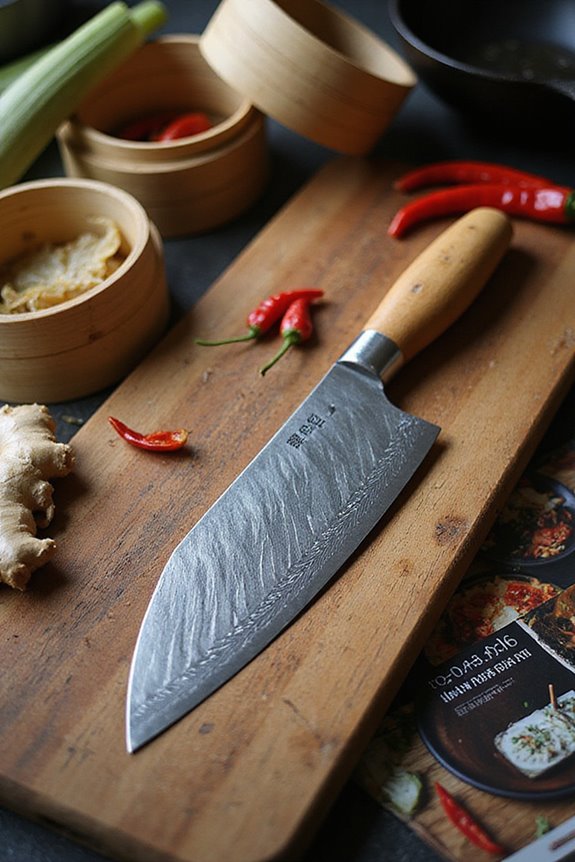
The art of selecting the right materials and construction for a quality Chinese cleaver can feel as delightful as unwrapping gifts during the holidays! When we look at blade materials, high-carbon stainless steel stands out for its durability and rust resistance. On the other hand, carbon steel excels in sharpness but needs more upkeep—like an adventurous pet!
Let’s consider construction techniques, too. A thick blade handles heavy tasks while a thinner blade takes on delicate cuts. And don’t overlook the handle! Wooden options offer a classic feel, but ergonomic plastic grips are comfy and low maintenance. Choosing the right combination guarantees our cleavers become trusted kitchen companions for years to come. Additionally, high-quality materials contribute to exceptional performance and edge retention, ensuring that our cleavers remain sharp and reliable for all our culinary adventures. It’s all about finding what works best for our culinary adventures!
Versatility in Usage
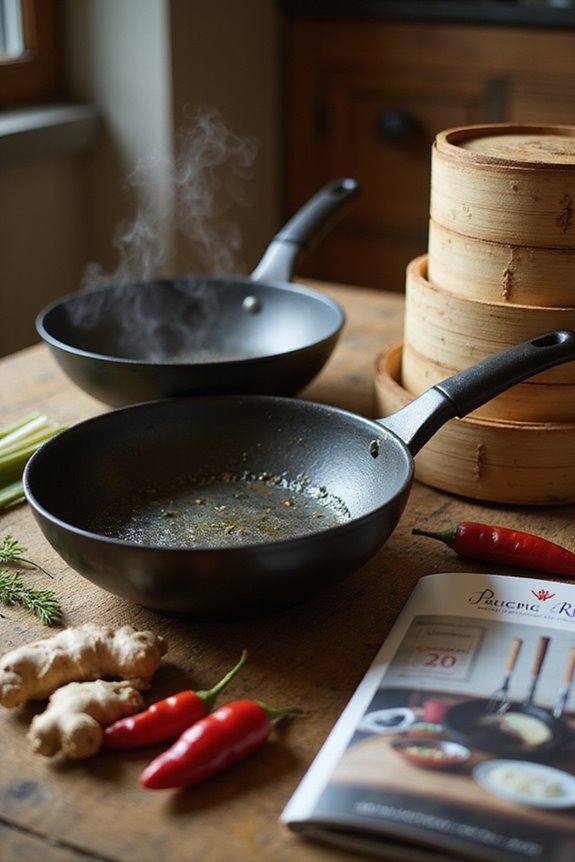
Versatility in a Chinese cleaver truly opens a world of culinary possibilities, making it feel like we’ve unwrapped the ultimate holiday gift! This magical tool shines with its multi-purpose applications—whether we’re chopping veggies, slicing meats, or crushing garlic. Imagine effortlessly shifting between tasks with one tool—how delightful is that?
- Ingredient Adaptability: It’s designed for all types of foods!
- Efficiency: The broad blade lets us scoop and transfer ingredients seamlessly.
- Speed: Its weight means less fatigue as we chop away.
Additionally, the cleaver’s design promotes ergonomic comfort, allowing us to work for longer periods without strain. As we explore new recipes, let’s embrace our cleaver’s versatility. With practice, we’ll become kitchen wizards, crafting amazing meals with surprising ease! So, let’s jump in and release our culinary creativity!
Understanding Edge Geometry
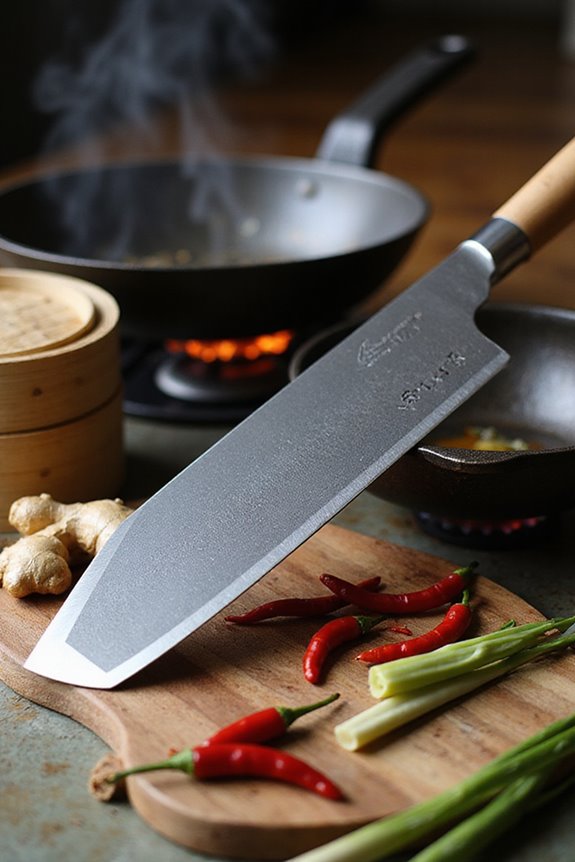
Understanding edge geometry is essential when it comes to harnessing the power of our beloved Chinese cleaver. The magic lies in the edge angles and bevel design. For slicing vegetables and light meats, look for sharper edges around 15° to 20°. Need a powerhouse for chopping bones? Check out cleavers with angles of 25° to 30°.
Here’s a quick tip:
- Double bevel edges often feature a 70/30 or 30/70 grind, perfect for right and left-handed cooks!
- A wide bevel width (up to 1 inch) adds strength for heavy-duty tasks. Additionally, choosing a cleaver made with high-quality materials can significantly enhance its performance and durability.
Finding the right balance between sharpness and toughness makes cooking delightful. So, let’s embrace these essential features and elevate our culinary adventures! Happy cooking!
Comparison With Other Types of Cleavers
- Chinese Cleaver: Agile and lightweight, it can chop veggies, slice meat, and even mince garlic!
- Meat Cleaver: Thick and heavy, designed for breaking bones, but lacks finesse.
- Western Chef’s Knife: Curved shape leads to a rocking motion, while our Chinese cleaver excels in precision. Understanding Chinese cleaver history helps us appreciate its evolution into a multifunctional kitchen star. It handles a wide range of tasks, blending efficiency and charm. Plus, its excellent heat conductivity allows the cleaver to perform consistently well during high-heat cooking. So, whether you’re tossing a stir-fry or prepping a feast, the Chinese cleaver is truly magical for every cook! Let’s embrace the delightful versatility!
Importance of Blade Weight and Balance
When using a Chinese cleaver, the importance of blade weight and balance can’t be overlooked, especially with all its magical multitasking abilities! A well-balanced cleaver makes those precision cuts feel effortless and reduces fatigue during extended use. Here’s why it matters:
- Weight Distribution: A cleaver’s weight concentrated in the blade helps with heavy chopping while maintaining blade agility for nimble tasks.
- Reduced Strain: This balance minimizes strain on our wrists, making repetitive kitchen tasks feel like a breeze.
- Control and Power: The right weight lets us harness power without sacrificing control, giving us confidence in our chopping skills.
In short, choosing a balanced cleaver enhances our cooking experience, letting us glide through meal prep like a holiday fairy!
Handle Comfort and Ergonomics
A comfortable handle is essential for wielding a Chinese cleaver with confidence and flair in the kitchen! Let’s explore the delightful aspects of handle materials and ergonomic shapes that make this possible.
- Wood handles offer a natural grip and absorb vibrations, giving a cozy feel.
- Composite or carbon fiber handles are lightweight and moisture-resistant, ensuring a secure grip even during the busiest holiday feasts.
- Ergonomically shaped handles fit our hands perfectly, reducing strain and making our chopping feel magical!
Remember to look for features like anti-slip textures and balanced designs to enhance comfort. With the right handle, we can create culinary masterpieces without feeling overwhelmed, turning every meal prep into a joyful task!
Maintenance and Sharpening Practices
Taking care of our trusty Chinese cleaver means keeping it in top shape for all our kitchen adventures! Here’s how we can keep our cleaver delightful and sharp.
Cleaning Techniques:
- Hand wash with mild soap and warm water, please!
- Avoid dishwashers to protect our cleaver’s wooden handle from warping.
- Dry it immediately to prevent rust and water spots.
Sharpening Tools:
- Use a whetstone, soaking it for 10-15 minutes.
- Sharpen at a consistent angle of 15° to 20° for peak results.
- Test sharpness on soft items like tomatoes.
Cultural Significance in Culinary Arts
In our culinary adventures, exploring the cultural significance of the Chinese cleaver reveals delightful layers of history and artistry. This versatile tool isn’t just for chopping; it holds deep cultural symbolism. It connects us to the rich tapestry of Chinese culinary heritage, showcasing centuries of skill and tradition.
- The cleaver’s design promotes stability and control, essential for achieving authentic textures.
- Mastering this tool symbolizes our commitment to craftsmanship, linking us to our roots.
As we slice and dice, we honor generations of cooks who’ve perfected their craft. Remember, every chop is a celebration of our shared culinary identity, making our kitchen feel like a vibrant part of history. So, let’s embrace this magical tool together!
Frequently Asked Questions
What Should I Look for in a Chinese Cleaver Brand?
When choosing a Chinese cleaver brand, we should look for strong brand reputation and excellent material quality. These factors guarantee we’re investing in a tool that will enhance our cooking experience and stand the test of time.
How Do I Choose the Right Size Cleaver for My Needs?
When choosing the right size cleaver, we should consider cleaver weight and blade thickness. A balanced approach guarantees comfort while maximizing efficiency, tailoring the cleaver to our specific chopping needs and cooking styles.
Can I Use a Chinese Cleaver for Fine Chopping?
When we first tried fine chopping with our Chinese cleaver, it felt like mastering a dance. With its versatility, we found that using push-chop techniques transformed our ingredients into perfectly diced veggies, making cooking a joy together.
Are There Specific Cleaning Methods for High Carbon Steel Cleavers?
Absolutely, we can take care of our high carbon steel cleavers together! By following maintenance tips like immediate drying and using protective oil, we’ll guarantee rust prevention and keep our cleavers performing beautifully for years.
How Does a Chinese Cleaver Compare to a Santoku Knife?
While the Chinese cleaver boasts remarkable versatility for hefty tasks, the Santoku knife offers a delicate balance for precise slicing. Together, they complement our kitchens, catering to various cooking needs and enhancing our culinary experiences.


